|
|
Post by Lee Martin on Jan 29, 2014 9:26:17 GMT -5
More fine shooting from David... Early Redhawk 5-1/2" with insert sights  Ruger 03 45C/45ACP and Redhawk w/ beaver-chewed Pachmayr Gripper.  Ruger 03 and Redhawk w/ Pachmayr Presentation. 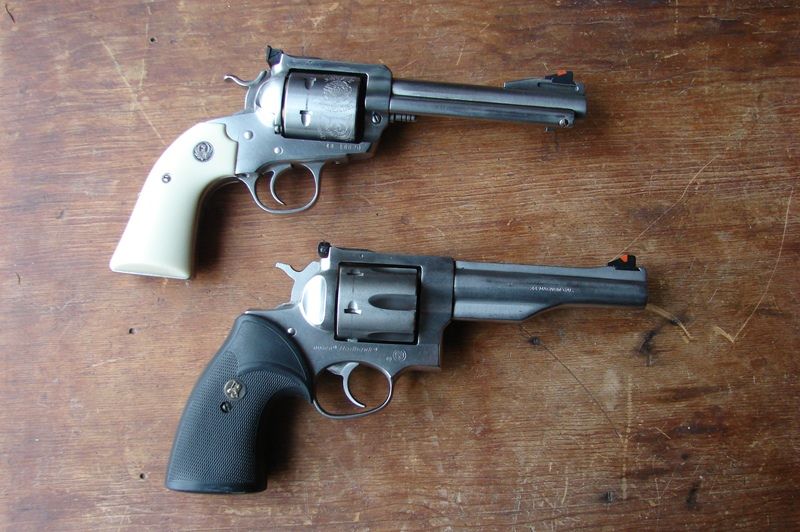 Redhawk, 20 below ZERO, 2x2 @ 200 yards. Sierra 210 JHC. 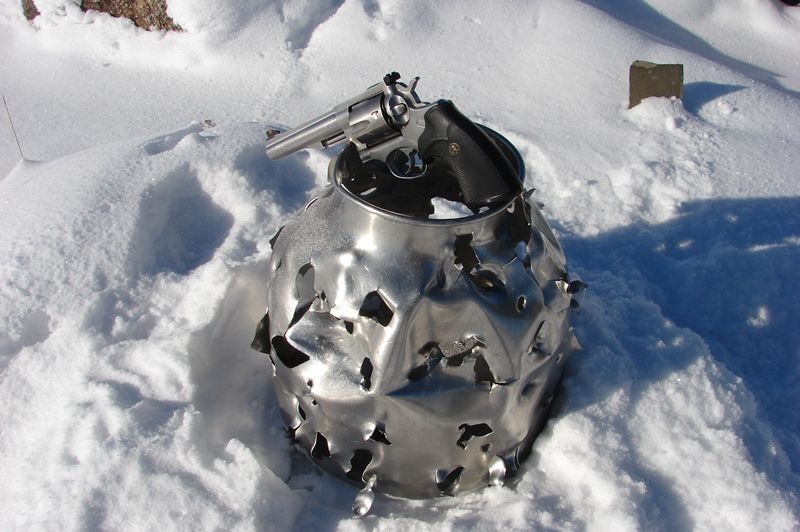 Ruger 03, 16 below ZERO, pot rolled by Sierra .45 240 JHC (1300 fps) @ 200 yards. 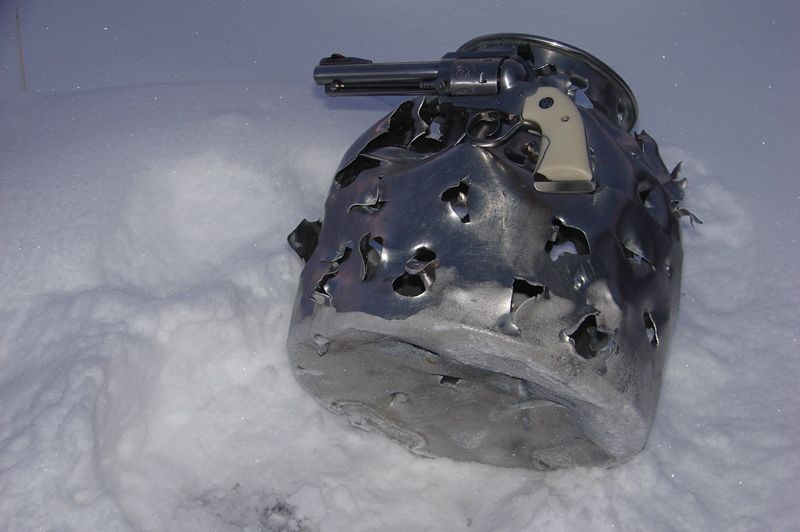 .45 Sierra 240 JHC and stainless steel fragments @ 200 yds 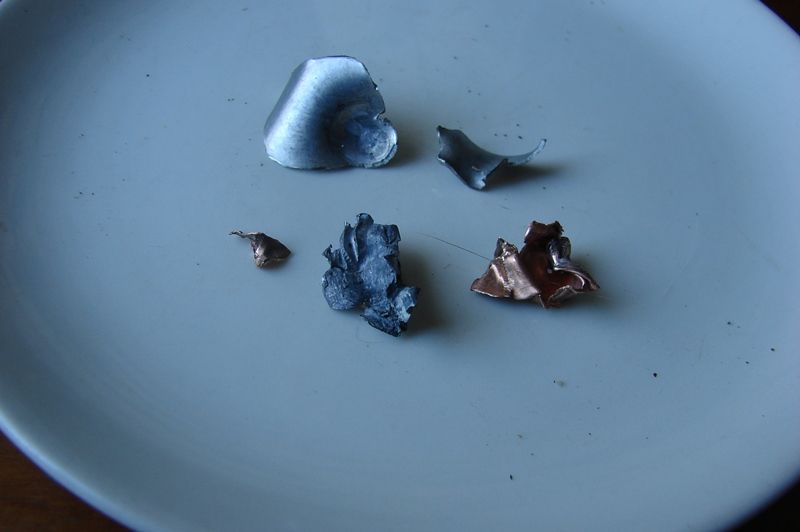 03 45 Colt, Speer 260 Gold Dot HP (900 fps) bounced off stainless @ 25 yards.  Ruger 03 comes in from the cold. 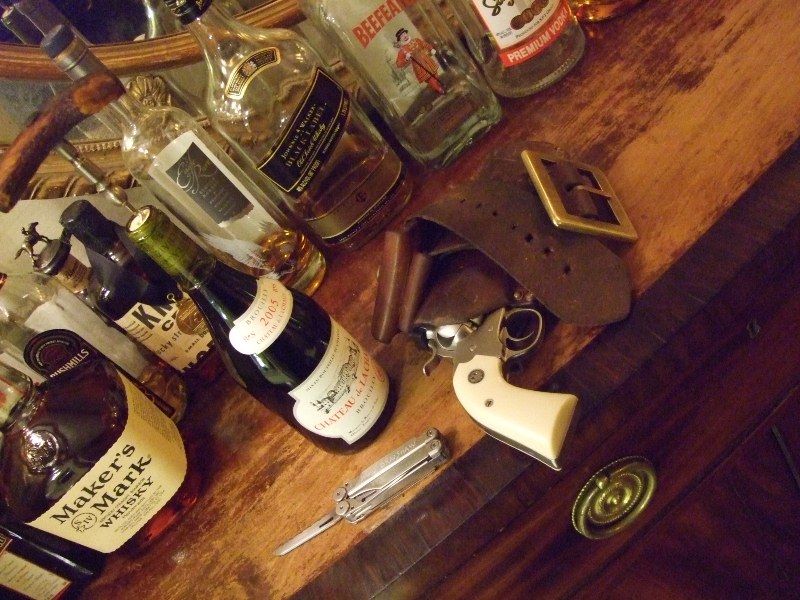 Silhouette Super .44 comes out of hibernation to punch steel @ 200 yards. 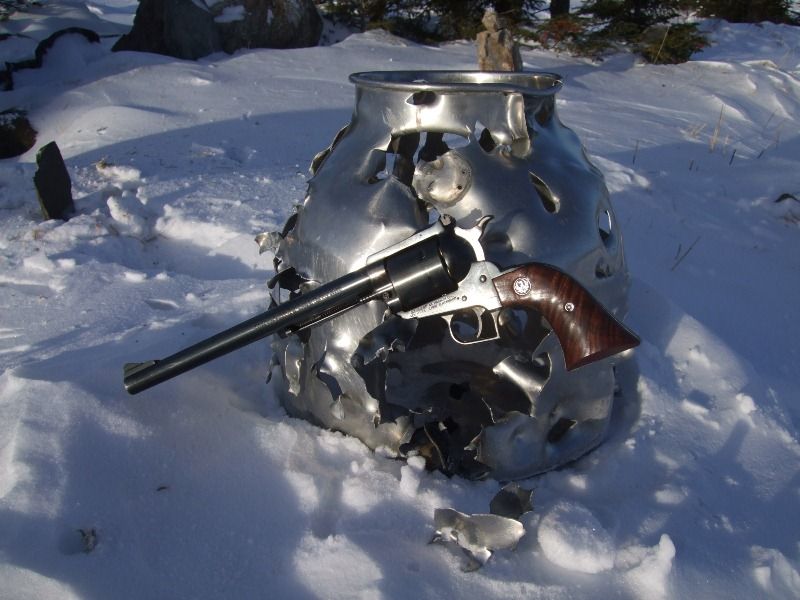 One reason I pushed for a long ejector----North Country cold. 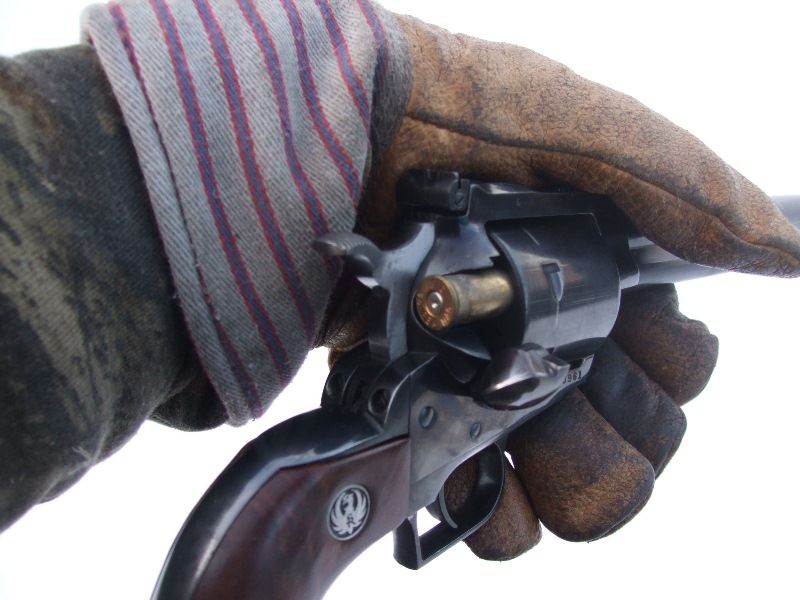 Ruger 03 ejector completely clears 45C (mag length) brass 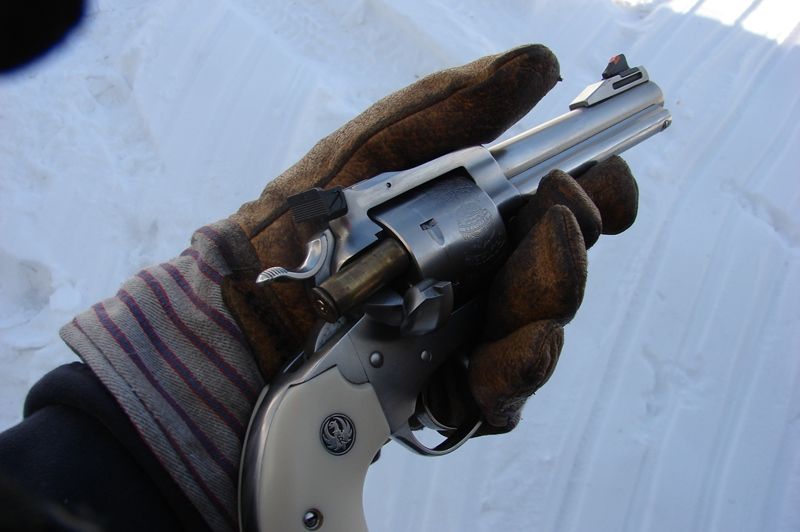 357 Maximum ejector clears mag length brass with 1/4" to spare.  -Lee www.singleactions.com"Building carpal tunnel one round at a time" |
|
|
|
Post by bradshaw on Jan 29, 2014 11:00:38 GMT -5
With the thermometer ranging -15 to -25 Fahrenheit,it sets the scene to illustrate the efficiency of the long ejector. The smooth chambers of Freedom Arms revolvers facilitate complete ejection with a shorter stroke. The Reamed finish of Ruger single action chambers tends to hold the case. To pluck each case under a hard freeze quickly stiffens fingers, even wearing gloves. Shortened shooting sessions nevertheless exhilarate. Walking 400 yards round trip through snow to check one shot on the chance of collecting a bullet, camera in bag under coat, is part of the process.
(The guns and ammo don't care about the freeze, including a Colt Delta Elite eating corroded Federal 180 JHP's. The Colt 10mm makes a serious showing against the revolvers, resisting wind drift far better than a .45 ACP.)
Thermometer the other day rose to +20F, yet a full value crosswind froze me much faster than a windless -20F. This wind bit the old Silhouette Super .44, which remembered experience on the firing line many years before to veritably rip open the tough stainless steel pot at 200 yards, send piece of shrapnel 15 feet, to be plucked from the snow for a photo.
Somewhat surprised to see, at 25 yards, the .45 Colt with Speer factory 260 Gold Dot HP (900 fps) bounce off the stainless cream separator. The same slug ventilates both sides of an oil drum. While from 200 yards from the same 03 revolver the Sierra 240 JHC over 27 grains 296 or H110 (1300 fps) tears holes. I would think that the 240 starting out at 1300 fps would drop to 900 fps at 200 yards. Yet the often visible impact of the uploaded .45 registers authority more serious than the factory .45 Colt at 25 yards.
David Bradshaw
|
|
|
|
Post by bigmuddy on Jan 29, 2014 12:13:10 GMT -5
"Cool pics" (pun intended). Notice the hammer pin on the Redhawk. The early 5.5" guns had the pin entering on the opposite side from the earlier 7.5" guns. Don't see those too often. I traded a 7.5" Redhawk for the first 5.5" gun that I saw. It was unusual to see a gun from Ruger that was not written up prior in the gun mags but that was the case with the 5.5" for me. Didn't have any idea they were being made. When I saw the gun in the case at a very small rural gun shop I thought it was a custom job. Mine too has the hammer pin like David's. I used that gun to take my first hand gunned deer. That was 1983.
It is my guess but those hammer pins were changed back because when using grips with a cut out for a speed loader nothing holds it into the frame.
David you really have to WANT to shoot to do it in those conditions.
Dan
|
|
|
|
Post by alukban on Jan 29, 2014 12:13:21 GMT -5
How the heck did a beaver get a chance to put their teeth into that Pachmayr?!
|
|
|
|
Post by bradshaw on Jan 29, 2014 14:02:28 GMT -5
bugmuddy.... no idea why Ruger switched the hammer pin to enter from the left. You are correct, a grip scalloped for a speed loader or this thin rubber of the Pachmayr on that side allows the pin to drift out. Mine is held with a screw. Like the RH 7-1/2", the 5-1/2" barrel is made from a drop forging, gun drilled, with a broach pulled through to cut the rifling. As i saw raw barrel forgings in the New Hampshire shop, I figure the barrels were drilled and broached in house. Most Ruger barrels at that time came from George Wilson in Connecticut. (Note: single actions were still made in Southport. I believe hammer forging machinery installed in New Hampshire didn't enter production until the late eighties or early nineties. While I can get the approximate date, someone here may have it in their head.)
alukban.... believe that beaver was actually a very sharp pen knife. I cannot abide wide finger grooves that spread my fingers and cause vertical stringing. The Pachmayr GRIPPER for the Redhawk, even with the finger grooves cut off, is something of an abomination itself----long & skinny. On the other hand, I find the Pachmayr GRIPPER for the T/C Contender sweet as fury in my hand.
While I shooter .44 mags in the 7-1/2" Redhawk with factory wood without complaint, recoil of the same loads, with same wood grips, is miserable from the 5-1/2" barrel. That big steel hump on the backstrap seems specially designed to murder the base of my thumb. (.44 Special not a problem.)
David Bradshaw
|
|
Fowler
.401 Bobcat
  
Posts: 3,670
|
Post by Fowler on Jan 29, 2014 14:36:22 GMT -5
Id bet money you were not getting 1300fps from H110 in those temps. I remember shooting some 24.0gr loads with a 335gr bullet in a 7 1/2" 45 colt Bisley over a chrono on a 5 degree day and discovered a load that was at or very close to 1300fps on a warm day wasn't breaking 1000fps on that cold afternoon. It seems H110 is pretty temperature sensitive in my experience.
Stainless Redhawks are such a interesting gun to me in that they have almost zero elegance to them, nothing like a Smith N frame does but then they reek of power, toughness, and usefulness, much like a Mack truck. Classic
|
|
cmh
.401 Bobcat
  
Posts: 3,745
|
Post by cmh on Jan 29, 2014 18:01:37 GMT -5
Nice revolvers Mr Bradshaw...... I never tire of seeing your 03  |
|
|
|
Post by seancass on Jan 29, 2014 19:11:01 GMT -5
Speaking of ejectors, my first Blackhawk was a Hunter. I had no idea of the frustration that awaited me when i finally got a standard length extractor. Why isn't the extractor long enough to clear cases on standard guns? What was the logic? (I almost posted this question in another thread but thought it more appropriate here in David's thread.) Also, i can't wait to find a range where i can play with revolvers at 200+ yards!  |
|
|
|
Post by jayhawker on Jan 29, 2014 22:42:15 GMT -5
Seancass,
Simple, the ejector housing is the same length as a 4 5/8 inch barrel. Ruger original Blackhawk was an improved Colt SA, with traditional Colt barrel lengths. Why make 2 lengthes of ejector housings? Like grip frames, ejector housings were interchangeable, except for the Bearcat. Early housings were steel, and I used to replace the aluminum housings on my fast draw Rugers to steel because I feel they point better. Understand this was on "race" guns which had aluminum barrels for use with blanks and primer powered wax loads.
|
|
|
|
Post by bradshaw on Jan 30, 2014 12:00:29 GMT -5
I have a feeling the Peacemaker length extractor came about with the shortest practical barrel----4-3/4"----which turned out to be one of the most beautiful objects of the Machine Age. As stated above, the one-size-fits-all proves less than satisfactory with longer barrels. As Bill Ruger, Jr., trransitioned from a prototype .357 Maximum with 1.490" case length in the Super Balckhawk frame, to stretched frame SRM prototypes for a 1.605" case and heavier bullets, I suggested that the extractor assembly work to completely eject the Maximum case. Years before I had wanted a longer ejector to unload the Super Blackhawk in cold weather, but had not met the Rugers. With some of the experimental .357 Maximum topping 75,000 PSI, the combination of long case and pressure gave me the argument I needed. Ruger, Jr., jumped on it and made the seven prototype SRMs with the 1-inch longer ejector. That was 1981. In 1982 Ruger, Jr., spotted as I shot the first two stainless Supers (7-1/2" and 10-1/2")at the Ruger farm in New Hampshire. The Revolvers had tapered barrels and ramp sights, I think even the 10-1/2-inch, with standard length stainless ejector assemblies. As I shot the 10-1/2" Creedmoor at 100 yards, iron sights, four shots went into 0.7-inch. I threw one, for a 2.7" 5-shot group on a pig I had painted on cardboard. I signed the target to Bill, Jr. Later, in discussing the stainless Super I suggested the 10-1/2" come with untapered barrel, Maximum length ejector, and screw-on target front sight. Which became the KS411N.
The KS411N set a revolver record on its first outing.
The prototype stainless Supers were tested with Federal 44A 240 JHP, the most accurate factory .44 magnum ever loaded, every bit as accurate as the very best handloads used in silhouette.
David Bradshaw
|
|
|
|
Post by seancass on Jan 30, 2014 13:24:56 GMT -5
I guess the extractor length seems pretty obvious now that you say it. But that doesn't mean I'm ok with it! The prototype stainless Supers were tested with Federal 44A 240 JHP, the most accurate factory .44 magnum ever loaded, every bit as accurate as the very best handloads used in silhouette. David Bradshaw Is this same ammo still available to the public? I know factory ammo evolves. |
|
|
|
Post by maxcactus on Jan 31, 2014 3:11:59 GMT -5
What in BLAZES is all that evil stuff behind Ruger # 03 in picture # 8?? Oh, it's wood!!! Now that we have that out of the way, I do so like Johnnie Walker Black Label and Marker's Mark. Knob Creek isn't bad atalll, either. Good stuff, Mr. Bradshaw, and as always, an excellent post. Thanks, Lee, for the assistance.
Max.
|
|
|
|
Post by paul105 on Jan 31, 2014 10:53:16 GMT -5
The prototype stainless Supers were tested with Federal 44A 240 JHP, the most accurate factory .44 magnum ever loaded, every bit as accurate as the very best handloads used in silhouette. David Bradshaw Is this same ammo still available to the public? I know factory ammo evolves. I think this is the ammo David's referencing -- Last year, I picked up a case (1,000 rnds) from an estate sale for $350. I just checked Federal's website, and the 44A is no longer cataloged. . 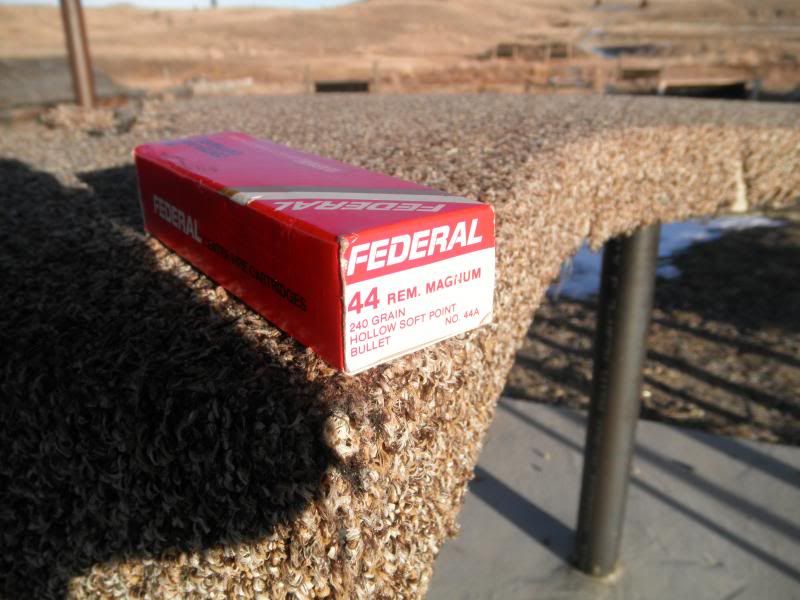 . Was testing some ammo in my New S&W m69 (4 1/4", 5 shot L Frame .44 Mag) -- the center group (5 rounds - 4 in one hole) was shot with the Federal 44A (above picture ammo) from a rest at 25 yds. Pretty sure the last round was operator error. . 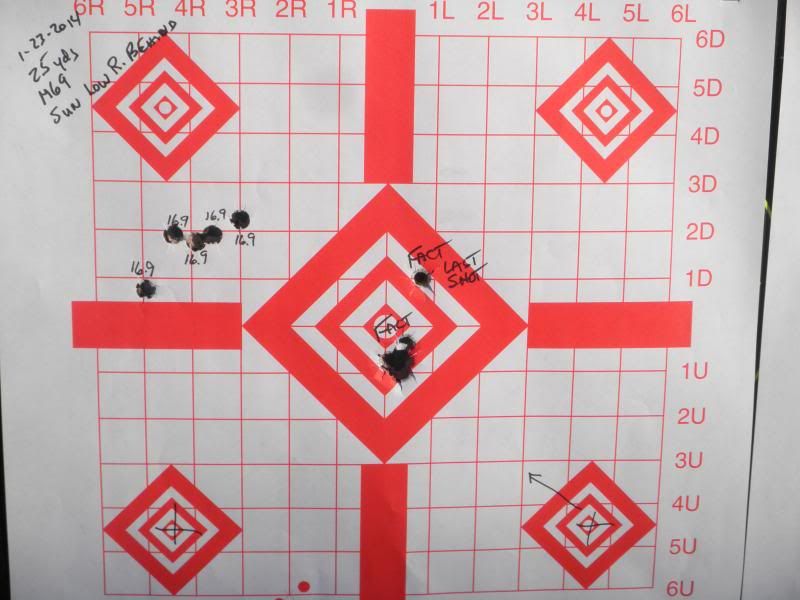 . By the way, the M69 is a great little gun. Once I settle on a load, it may replace the 329 as my everyday carry piece. FWIW, Paul |
|
|
|
Post by bradshaw on Jan 31, 2014 11:45:20 GMT -5
My remaining stock of Federal 44A 240 JHP dates back quite a while. The bullet is the spitting image of the Sierra 240 JHC (Jacketed Hollow Cavity), but not to be confused, as I have watched the bullet being formed in the old heavy punch presses at Federal's Minnesota factory. The 44A case received an asphaltic coating, which Lee Jurras and I have discussed, and for which Lee provided more background. Sierra's .44 220 and 250 grain FPJ (Full Profile Jacket) was directed at IHMSA silhouette, and these bullets are the accuracy equal of the 240 JHC. I worked up experimental loads with the Sierra 220 FPJ for Hugh Reed at Federal. Federal loaded the bullet in nickel plated cases, also with asphaltic sealant, which ammo is coded 44C. Like the Federal 240 JHP, the Federal .44 mag 180 JHP resembles the Sierra 180 JHC bullet. Never asked about core composition of these Federal JHPs, but in use on deer and livestock gained impression not quite as hard as the Sierra. No proof, so I won't speculate further.
Fowler.... there is no way in hell my .45 Colt Sierra 240 JHC over 27/296 (1,300 fps in 5-1/2" Ruger 03)drops 300 fps at 50-degrees below freezing. The trajectory story, windrift, and the emphatic impact at 200 yards leave no doubt that, while velocity certainly doesn't rise, neither dose it drop precipitously. I, too, would like to know actual velocity, but it is all I can handle to unbundle a camera for 60 seconds and hope the thing works. Perhaps a load of 296/H110 with air space may falter in severe cold. However, the Sierra .44 210 JHC over 22.4/296 is a mild load, yet very accurate and consistent under this hard cold.
If that isn't enough, badly corroded Federal 10mm 180 JHP fired from my Colt Delta Elite at 15-below ZERO hit the can @ 200 yards, and the chip of front sight wasn't noticably thicker than for sane shooting conditions. And I've shot a bunch of thrown water (ice) jugs with this corroded 10mm Federal without a misfire. Tried aGlock 27 with Remington .40 S&W stored in the same rightful conditions, expiencing quite a few misfires.
David Bradshaw
|
|
Fowler
.401 Bobcat
  
Posts: 3,670
|
Post by Fowler on Jan 31, 2014 18:41:28 GMT -5
David, I didn't say you would loose a full 300fps in those temps but did on that given day. I was using Win WLP primers at the time and I have switched to CCI350 primers for H110 exclusively but I don't know how much that helps, I have noticed I get higher velocities with that primer but also higher velocity spreads.
I'm not much of a chrono guy, I know if a load is mild or rock and dynamite as you like to say, if it is +/- a few fps from what I think it should be in my head who cares? I care that a load is accurate and heavy enough for the job at hand.
|
|